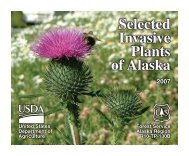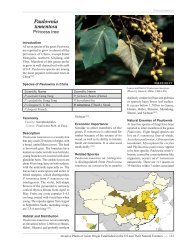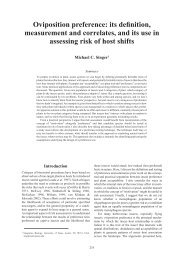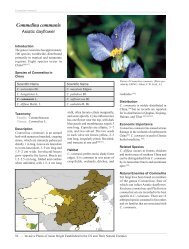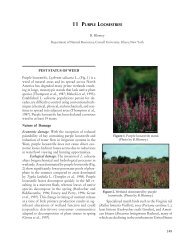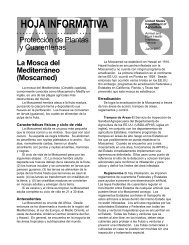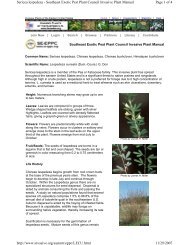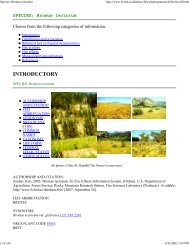A review of literature and field practices focused on ... - Invasive.org
A review of literature and field practices focused on ... - Invasive.org
A review of literature and field practices focused on ... - Invasive.org
Create successful ePaper yourself
Turn your PDF publications into a flip-book with our unique Google optimized e-Paper software.
less growth under the fabric, but was “stiff” <str<strong>on</strong>g>and</str<strong>on</strong>g> thus somewhat difficult to use except in<br />
straight runs. It is made <str<strong>on</strong>g>of</str<strong>on</strong>g> woven slit-film polypropylene (Lay<str<strong>on</strong>g>field</str<strong>on</strong>g> LP200, 4 oz/yd 2 ;<br />
www.lay<str<strong>on</strong>g>field</str<strong>on</strong>g>group.com). The n<strong>on</strong>-woven fabric was c<strong>on</strong>siderably easier to work with,<br />
especially when working around obstacles such as trees. It is made <str<strong>on</strong>g>of</str<strong>on</strong>g> UV-stabilized<br />
needle-punched n<strong>on</strong>-woven polypropylene fibers (Lay<str<strong>on</strong>g>field</str<strong>on</strong>g> LP6 & LP8, 5.5 & 7.5 oz/yd 2 ;<br />
www.lay<str<strong>on</strong>g>field</str<strong>on</strong>g>group.com).<br />
Most <str<strong>on</strong>g>of</str<strong>on</strong>g> the applicati<strong>on</strong>s were <strong>on</strong> forested or forest-edge sites. For the method used,<br />
timing <str<strong>on</strong>g>of</str<strong>on</strong>g> applicati<strong>on</strong> did not matter. Stems were cut to the ground <str<strong>on</strong>g>and</str<strong>on</strong>g> piled where they<br />
were cut. The fabric was loosely laid over the cut stems <str<strong>on</strong>g>and</str<strong>on</strong>g> extended a minimum <str<strong>on</strong>g>of</str<strong>on</strong>g> 2’<br />
bey<strong>on</strong>d the existing edge <str<strong>on</strong>g>of</str<strong>on</strong>g> the knotweed patch. Extensi<strong>on</strong> <str<strong>on</strong>g>of</str<strong>on</strong>g> the fabric was limited to 2’<br />
because the material was costly <str<strong>on</strong>g>and</str<strong>on</strong>g> because frequent m<strong>on</strong>itoring allowed for needed<br />
additi<strong>on</strong> <str<strong>on</strong>g>of</str<strong>on</strong>g> fabric to cover edge sprouting. The fabric was <strong>on</strong>ly secured with stakes <strong>on</strong><br />
steep slopes, elsewhere rocks <str<strong>on</strong>g>and</str<strong>on</strong>g> logs from the site were used to hold the fabric down.<br />
Fabric was used <strong>on</strong> 3 streambanks. Rocks were used to secure the stream-side edge in<br />
water <str<strong>on</strong>g>and</str<strong>on</strong>g> no erosi<strong>on</strong> problems were observed after 2 seas<strong>on</strong>s. It was important to lay<br />
the fabric loosely over the cut stems. Taught fabric led to stems poking through the<br />
fabric. This was especially important when covering large old patches that tended to put<br />
up a lot <str<strong>on</strong>g>of</str<strong>on</strong>g> growth under the fabric. During m<strong>on</strong>itoring visits, the stems growing under<br />
the fabric were crushed by walking <str<strong>on</strong>g>and</str<strong>on</strong>g> stomping <strong>on</strong> the fabric.<br />
Each site was m<strong>on</strong>itored every three weeks during the 2004 <str<strong>on</strong>g>and</str<strong>on</strong>g> 2005 growing seas<strong>on</strong>s.<br />
The need for visits every 3 weeks will be re-evaluated for the 2006 seas<strong>on</strong>. In the 2006<br />
seas<strong>on</strong>, the plan is to uncover selected areas <str<strong>on</strong>g>and</str<strong>on</strong>g> watch for knotweed growth. If no<br />
knotweed is found, the areas will be planted with native trees <str<strong>on</strong>g>and</str<strong>on</strong>g> shrubs. Having 2<br />
seas<strong>on</strong>s <str<strong>on</strong>g>of</str<strong>on</strong>g> experience, it is expected that knotweed eradicati<strong>on</strong> using the geotextiles with<br />
frequent m<strong>on</strong>itoring will take from 3 to 6 years. It was suggested that smothering with<br />
geotextiles was applicable to l<strong>on</strong>g linear (10’ – 20’ wide) applicati<strong>on</strong>s <str<strong>on</strong>g>and</str<strong>on</strong>g> to rectangular<br />
areas up to approximately 20’ x 50’. For larger areas, it was suggested that material costs<br />
<str<strong>on</strong>g>and</str<strong>on</strong>g> maintenance requirements would be restrictive (Sally Nickels<strong>on</strong>, Wildlife<br />
Biologist/Watershed Ecologist, Cedar River Watershed, Washingt<strong>on</strong>, pers<strong>on</strong>al<br />
communicati<strong>on</strong>).<br />
Case Study: Green/Duwamish River Upper Watershed, King County Noxious<br />
Weed C<strong>on</strong>trol Program, King County, WA<br />
C<strong>on</strong>trol <strong>on</strong> roughly 7 acres <str<strong>on</strong>g>of</str<strong>on</strong>g> knotweed was initiated in 2004 using multiple methods<br />
including stem injecti<strong>on</strong>, foliar applicati<strong>on</strong>, manual c<strong>on</strong>trol, mowing <str<strong>on</strong>g>and</str<strong>on</strong>g> smothering with<br />
heavy grade geotextile fabric. Covering with a geotextile was a part <str<strong>on</strong>g>of</str<strong>on</strong>g> the c<strong>on</strong>trol<br />
applicati<strong>on</strong> in a county park, where herbicide use was discouraged. There were a number<br />
<str<strong>on</strong>g>of</str<strong>on</strong>g> knotweed st<str<strong>on</strong>g>and</str<strong>on</strong>g>s within the park area that received the geotextile, the largest covering<br />
10,000 square feet. A woven geotextile was used (Sunbelt, 2 oz/yd 2 ; DeWitt Company,<br />
Inc.). The first attempt at the site to cover was reported to be a failure, mainly due to a<br />
large degree <str<strong>on</strong>g>of</str<strong>on</strong>g> sprouting al<strong>on</strong>g the edges <str<strong>on</strong>g>of</str<strong>on</strong>g> the c<strong>on</strong>trol area. It took some experience to<br />
develop the method that eventually proved to be successful. The method involved<br />
mowing the knotweed to the ground, covering the st<str<strong>on</strong>g>and</str<strong>on</strong>g> with the geotextile with a<br />
minimum 6” overlap at adjacent edges <str<strong>on</strong>g>of</str<strong>on</strong>g> fabric, staking the perimeter <str<strong>on</strong>g>of</str<strong>on</strong>g> the treatment<br />
14


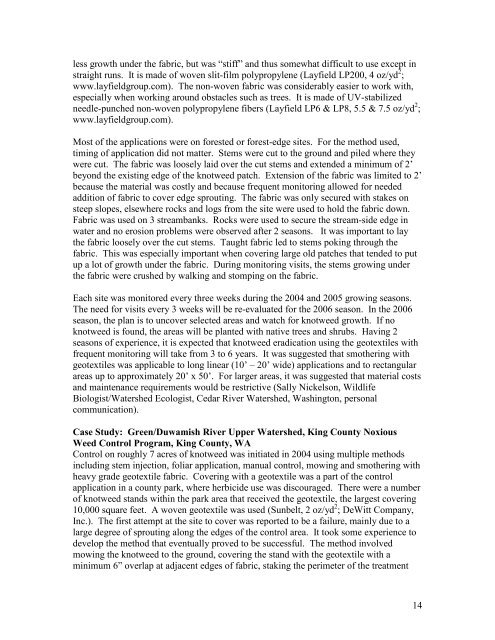

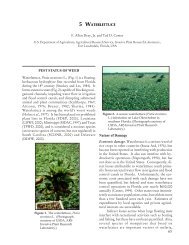

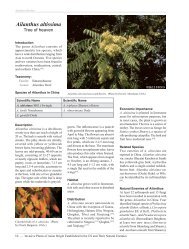
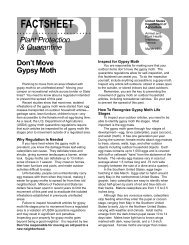
![A Guide to the Control and Management of Invasive Phragmites [PDF]](https://img.yumpu.com/27321025/1/190x190/a-guide-to-the-control-and-management-of-invasive-phragmites-pdf.jpg?quality=85)
